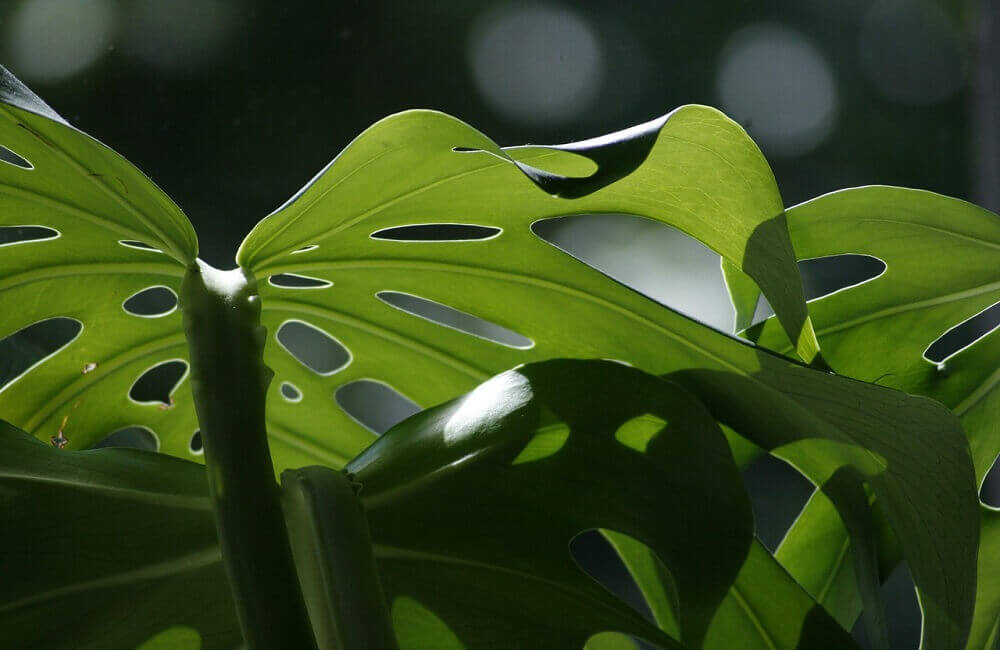
Monstera is among the list of highly prized houseplants today, adding peculiar beauty to any space with its odd-looking leaves featuring wide, natural holes. This genus of evergreen, climbing vine has over 40 species, all exhibiting leaves with a perforated design. The fenestration helps the Monstera deliciosa, native to tropical regions, conserve energy that is required to maintain the leaves and plant. Additionally, it even allows the leaves and plants underneath to get sufficient sunlight.
Table of Contents
Monstera Brief Plant Summary:
Family: Araceae
Botanical Name: Monstera deliciosa
Common Names: Swiss cheese plant, Swiss plant, ceriman, custard plant, fruit salad plant
Native plant Range: Mexico to Panama
Characteristics: Foliage, evergreen
Habit: Climbing
Sunlight: Partial shade
Exposure: Sheltered
Soil Moisture: Moist but well-drained
Soil pH: Acid, Alkaline, Neutral
Flower: White flowers, rarely flower indoors
Fruit: Creamy fruit, rarely bears fruit indoors
Toxicity: Severe discomfort, skin and eye irritant
Pests, Diseases: Generally disease-free, but may be attacked by red spider mites, thrips, mealybugs, and scales.
Can You Propagate a Monstera Plant Without a Node?
The demand for the Monstera houseplant, especially the much-loved Monstera deliciosa, also known as the Swiss Cheese plant because of the perforated leaves, has led to many questions about its propagation. Most houseplant owners are keen to explore quick and easy ways to propagate and grow their Monstera plants. There’s growing doubt and confusion regarding one particular method of propagation, garnering threads of comments and questions in several gardening forums and blogs. Many plant owners are of the view that it is possible to propagate the Monstera plant without a node. Many others disregard it as impossible. Let’s find out the real answer to end this confusion.
The short, quick, and straightforward answer to the question is: No. It is not possible to propagate a Monstera plant from a cutting without the presence of a node, which is crucial for any growth to take place at all. To understand why this is so, it is first important to know what the term ‘node’ actually means.
What Are Nodes And Internodes?
If you look at a plant, you will find the stem has different sections; points from where branches and/or petioles emerge, leading to the growth of leaves, flowers, and fruits; and other portions from where nothing grows. The former point, where new growth like buds, leaves, etc. emerges, is referred to as nodes. The portions with no growth are actually areas between the nodes and are simply referred to as internodes.
On the Monstera plant, the point from where the petiole – the stalk that attaches the leaf to the stem – shoots out is a node. You will also find around this area, the emergence of the aerial roots. The propagation of the plant through stem cuttings becomes possible when this area is included. If you notice carefully around this area, you might be able to see new nodes appearing as a white or brown knob-like growth. The appearance of a new Monstera node is subject to the maturity of your Monstera plant. Often, the part of the stem with nodes can appear thicker than the internodes and exhibit a dry-looking, brown ring around your Monstera stem.
Can You Propagate Monstera Deliciosa Without A Node?
While there isn’t any clear answer to why the confusion arose in the first place, there are certainly some possible theories which can explain it. The most likely explanation about the confusion regarding the propagation can be attributed to the ability of a Monstera leaf to stay fresh for a long time when placed in water. A new houseplant owner might have tried to see if the Monstera leaves can grow by themselves if planted separately in water. The confusion could have been further fueled by the appearance of roots from the Monstera leaves. However, it is not unusual for Monstera leaves to bear roots when planted in water for a long period. The Monstera leaf, even with the roots, can stay fresh for months in water but that’s where their ability ends. The leaf will not lead to any new growth of stem or new leaf or give rise to a new Monstera plant. At best, they can be used to add a decorative touch on their own around the house or even included in an aesthetic floral arrangement for the center table.
Another possibility is that some new and inexperienced plant parents might have planted a stem cutting of Monstera. They might have failed to notice the presence of a node in the cutting, which can be hard to distinguish or identify sometimes. On seeing the stem cutting grow into a new Monstera plant, they might have prematurely and wrongfully concluded that they had propagated Monstera cuttings without a node.
Accurate Methods Of Propagation Of Your Monstera Plant:
Propagation of your Monstera plants is possible through various methods. The most common method is stem cutting. Other means include using the seeds, transplanting of offshoots separated from the parent plant and air layering. The process for each of these methods is briefly explained below for clarity.
Monstera Propagation Through Stem Cuttings:
- Making the Cut:
- First identify the perfect area to make the cutting.
- Take proper care to include at least a node.
- The cut should be performed below the node using a sterilized and sharp knife or pruning shears to avoid getting the plant infected.
- Avoid making sawing motions and make a clean cut.
- It is best if your Monstera stem cutting also has an aerial root and a few healthy leaves to ensure faster and prosperous growth.
- Rooting Your Monstera Stem Cuttings:
- Once you have successfully taken the stem cuttings from your Monstera plant, you can either root them in soil or in water.
- Let your cuttings dry out to allow the cut to scab over and prevent any rot.
- If you are rooting in water, use a tall container to keep the stem upright.
- If rooting in soil, use a well-draining soil mix and start with a small pot, to ensure there is no retention of moisture in the soil as such conditions are harmful for Monsteras.
Monstera Propagation Using Suckers or Offshoots:
You can also properly propagate your Monstera plant by using their suckers or offshoots. The offshoots can be separated from the parent plant and divided into several sections, each about a foot long. You can either take the suckers with or without roots. Gently press each of these Monstera offshoots into the soil and after they sprout, they are ready to be transplanted into a new pot.
Monstera Propagation by Air Layering:
Another method for propagating your Monstera plant is by air layering.
- First, identify a node below the stem you want to propagate and then make a small cut right above it.
- Wrap the area including the node and the cut with damp sphagnum moss.
- Cover the moss with a clear plastic bag having air vents and gently tie it off.
- Be sure to keep the area moist by spraying water every few days
- New roots should appear in a few months, which can then be clipped and planted.
Monstera Propagation by Seeds:
One of the rare means of Monstera plant propagation is by using the seeds. Spreading the seeds, gently covering with a thin layer of soil and keeping the area moist will ensure germination. The rarity of this method is owing to the long time it takes for a Swiss Cheese plant to bear fruit. It takes about a year or more for the fruit to mature once the flowers are produced. The seeds also come with a short shelf life and need to be used soon to ensure they remain viable. The other issue is the extremely slow rate of development of the seedlings. However, the plant rarely flowers or bears fruits when they are grown indoors.
Once the young Monstera plants start to grow, don’t be alarmed if you do not see any fenestration on the leaves. It will take at least a year or two for the young Monstera plants to develop the perforations. With the maturity of the plants, the leaves grow larger and broader, till the peculiar holes begin to appear.
There are other plant species that have the ability to generate new plants just from their leaves or even a small portion of a leaf, without the presence of a node. But in the case of your Swiss Cheese plant, unfortunately, that’s not the case. Aside from the above-mentioned methods of propagation, you will not be able to generate new growth or new plants from any part of your Monstera plant. Certainly not without a node.

Ranjan Singh Moirangthem is a media professional based in India, currently working as a freelance copywriter. Growing up in a hill station and now living in a concrete jungle, he finds solace in the green corners of the city, be it parks or his housing society garden. He’s even passionate about plants and gardening and shares his experience by writing in-depth and well-researched articles for our readers.
